Residential Status of a Company in Australia and Taxation on Capital Gains Assets
VerifiedAdded on 2023/06/07
|9
|1440
|79
AI Summary
This article discusses the three methods to test the residential status of a company in Australia and the taxation on capital gains assets. It also explains the deductions and taxable amounts for non-income generating assets. The article includes case laws and examples to provide a better understanding of the topic.
Contribute Materials
Your contribution can guide someone’s learning journey. Share your
documents today.
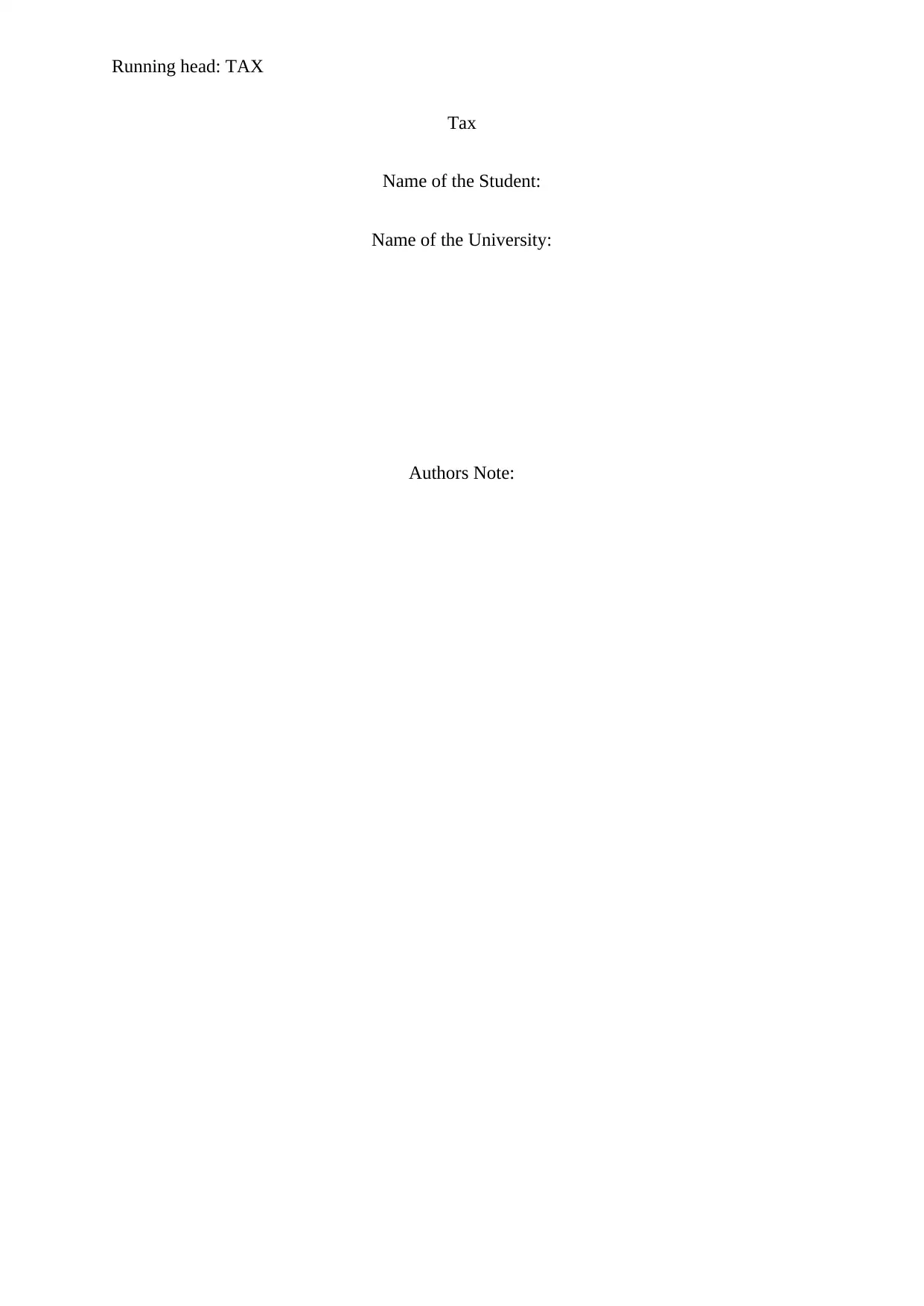
Running head: TAX
Tax
Name of the Student:
Name of the University:
Authors Note:
Tax
Name of the Student:
Name of the University:
Authors Note:
Secure Best Marks with AI Grader
Need help grading? Try our AI Grader for instant feedback on your assignments.
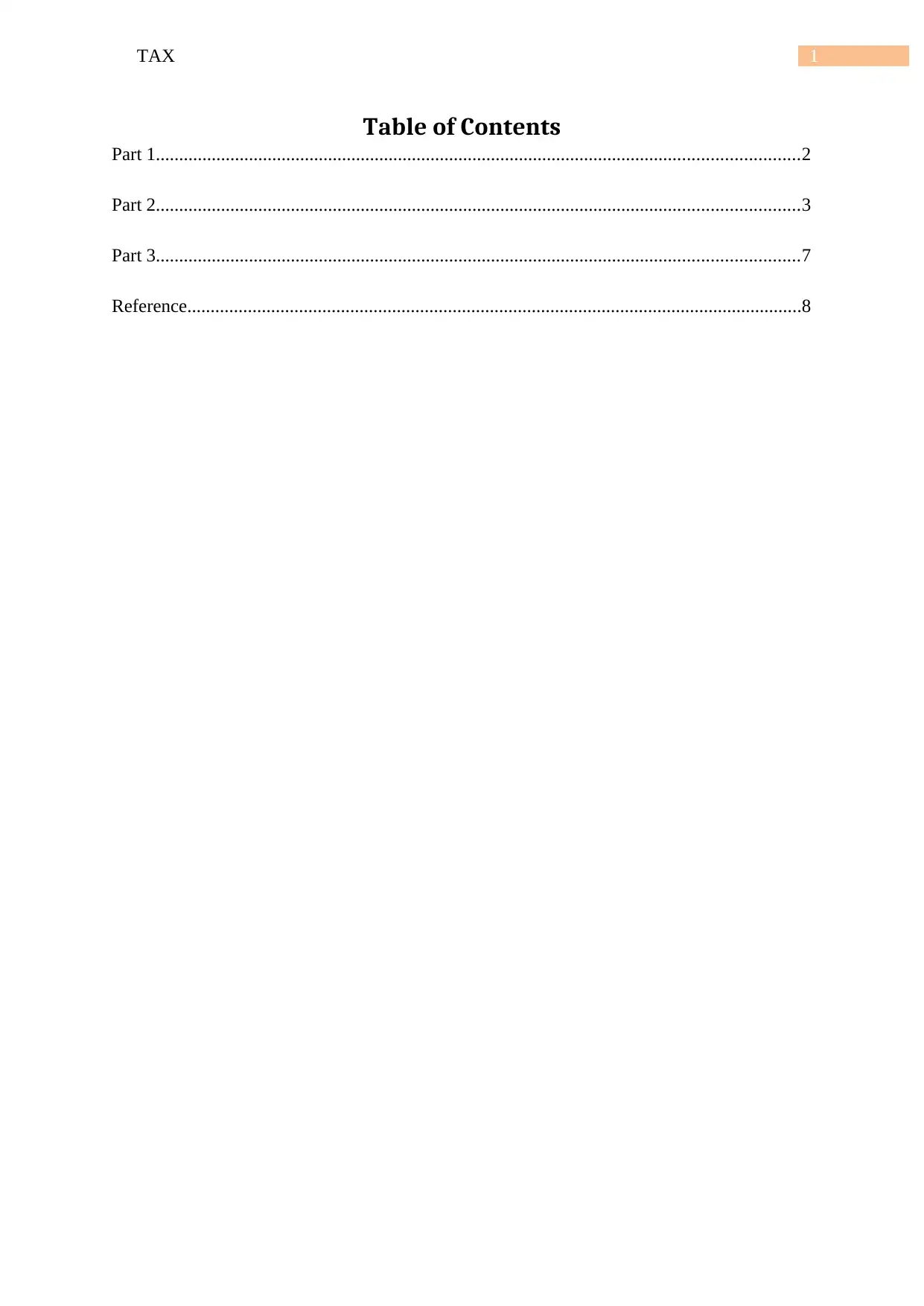
1TAX
Table of Contents
Part 1..........................................................................................................................................2
Part 2..........................................................................................................................................3
Part 3..........................................................................................................................................7
Reference....................................................................................................................................8
Table of Contents
Part 1..........................................................................................................................................2
Part 2..........................................................................................................................................3
Part 3..........................................................................................................................................7
Reference....................................................................................................................................8
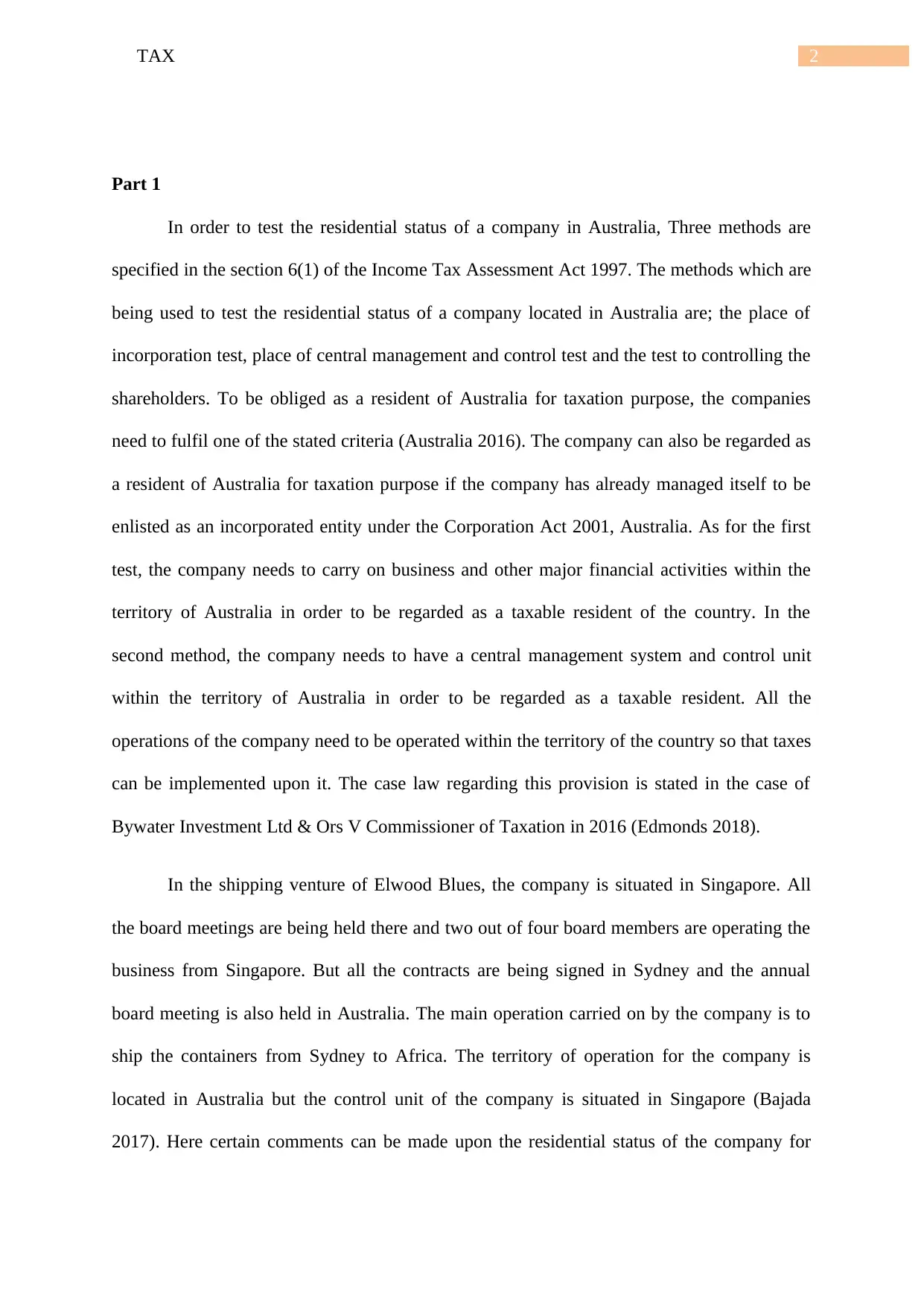
2TAX
Part 1
In order to test the residential status of a company in Australia, Three methods are
specified in the section 6(1) of the Income Tax Assessment Act 1997. The methods which are
being used to test the residential status of a company located in Australia are; the place of
incorporation test, place of central management and control test and the test to controlling the
shareholders. To be obliged as a resident of Australia for taxation purpose, the companies
need to fulfil one of the stated criteria (Australia 2016). The company can also be regarded as
a resident of Australia for taxation purpose if the company has already managed itself to be
enlisted as an incorporated entity under the Corporation Act 2001, Australia. As for the first
test, the company needs to carry on business and other major financial activities within the
territory of Australia in order to be regarded as a taxable resident of the country. In the
second method, the company needs to have a central management system and control unit
within the territory of Australia in order to be regarded as a taxable resident. All the
operations of the company need to be operated within the territory of the country so that taxes
can be implemented upon it. The case law regarding this provision is stated in the case of
Bywater Investment Ltd & Ors V Commissioner of Taxation in 2016 (Edmonds 2018).
In the shipping venture of Elwood Blues, the company is situated in Singapore. All
the board meetings are being held there and two out of four board members are operating the
business from Singapore. But all the contracts are being signed in Sydney and the annual
board meeting is also held in Australia. The main operation carried on by the company is to
ship the containers from Sydney to Africa. The territory of operation for the company is
located in Australia but the control unit of the company is situated in Singapore (Bajada
2017). Here certain comments can be made upon the residential status of the company for
Part 1
In order to test the residential status of a company in Australia, Three methods are
specified in the section 6(1) of the Income Tax Assessment Act 1997. The methods which are
being used to test the residential status of a company located in Australia are; the place of
incorporation test, place of central management and control test and the test to controlling the
shareholders. To be obliged as a resident of Australia for taxation purpose, the companies
need to fulfil one of the stated criteria (Australia 2016). The company can also be regarded as
a resident of Australia for taxation purpose if the company has already managed itself to be
enlisted as an incorporated entity under the Corporation Act 2001, Australia. As for the first
test, the company needs to carry on business and other major financial activities within the
territory of Australia in order to be regarded as a taxable resident of the country. In the
second method, the company needs to have a central management system and control unit
within the territory of Australia in order to be regarded as a taxable resident. All the
operations of the company need to be operated within the territory of the country so that taxes
can be implemented upon it. The case law regarding this provision is stated in the case of
Bywater Investment Ltd & Ors V Commissioner of Taxation in 2016 (Edmonds 2018).
In the shipping venture of Elwood Blues, the company is situated in Singapore. All
the board meetings are being held there and two out of four board members are operating the
business from Singapore. But all the contracts are being signed in Sydney and the annual
board meeting is also held in Australia. The main operation carried on by the company is to
ship the containers from Sydney to Africa. The territory of operation for the company is
located in Australia but the control unit of the company is situated in Singapore (Bajada
2017). Here certain comments can be made upon the residential status of the company for
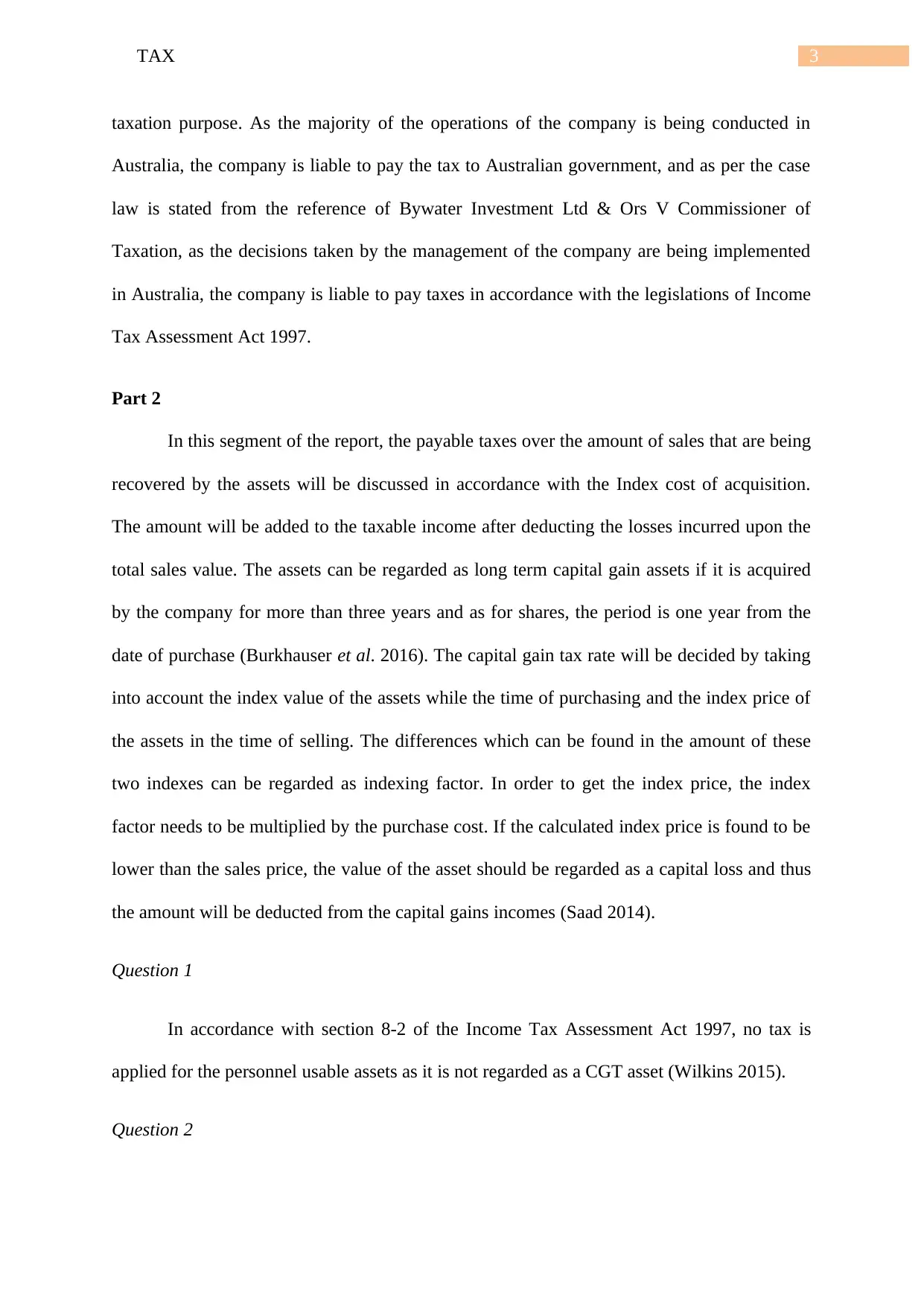
3TAX
taxation purpose. As the majority of the operations of the company is being conducted in
Australia, the company is liable to pay the tax to Australian government, and as per the case
law is stated from the reference of Bywater Investment Ltd & Ors V Commissioner of
Taxation, as the decisions taken by the management of the company are being implemented
in Australia, the company is liable to pay taxes in accordance with the legislations of Income
Tax Assessment Act 1997.
Part 2
In this segment of the report, the payable taxes over the amount of sales that are being
recovered by the assets will be discussed in accordance with the Index cost of acquisition.
The amount will be added to the taxable income after deducting the losses incurred upon the
total sales value. The assets can be regarded as long term capital gain assets if it is acquired
by the company for more than three years and as for shares, the period is one year from the
date of purchase (Burkhauser et al. 2016). The capital gain tax rate will be decided by taking
into account the index value of the assets while the time of purchasing and the index price of
the assets in the time of selling. The differences which can be found in the amount of these
two indexes can be regarded as indexing factor. In order to get the index price, the index
factor needs to be multiplied by the purchase cost. If the calculated index price is found to be
lower than the sales price, the value of the asset should be regarded as a capital loss and thus
the amount will be deducted from the capital gains incomes (Saad 2014).
Question 1
In accordance with section 8-2 of the Income Tax Assessment Act 1997, no tax is
applied for the personnel usable assets as it is not regarded as a CGT asset (Wilkins 2015).
Question 2
taxation purpose. As the majority of the operations of the company is being conducted in
Australia, the company is liable to pay the tax to Australian government, and as per the case
law is stated from the reference of Bywater Investment Ltd & Ors V Commissioner of
Taxation, as the decisions taken by the management of the company are being implemented
in Australia, the company is liable to pay taxes in accordance with the legislations of Income
Tax Assessment Act 1997.
Part 2
In this segment of the report, the payable taxes over the amount of sales that are being
recovered by the assets will be discussed in accordance with the Index cost of acquisition.
The amount will be added to the taxable income after deducting the losses incurred upon the
total sales value. The assets can be regarded as long term capital gain assets if it is acquired
by the company for more than three years and as for shares, the period is one year from the
date of purchase (Burkhauser et al. 2016). The capital gain tax rate will be decided by taking
into account the index value of the assets while the time of purchasing and the index price of
the assets in the time of selling. The differences which can be found in the amount of these
two indexes can be regarded as indexing factor. In order to get the index price, the index
factor needs to be multiplied by the purchase cost. If the calculated index price is found to be
lower than the sales price, the value of the asset should be regarded as a capital loss and thus
the amount will be deducted from the capital gains incomes (Saad 2014).
Question 1
In accordance with section 8-2 of the Income Tax Assessment Act 1997, no tax is
applied for the personnel usable assets as it is not regarded as a CGT asset (Wilkins 2015).
Question 2
Secure Best Marks with AI Grader
Need help grading? Try our AI Grader for instant feedback on your assignments.
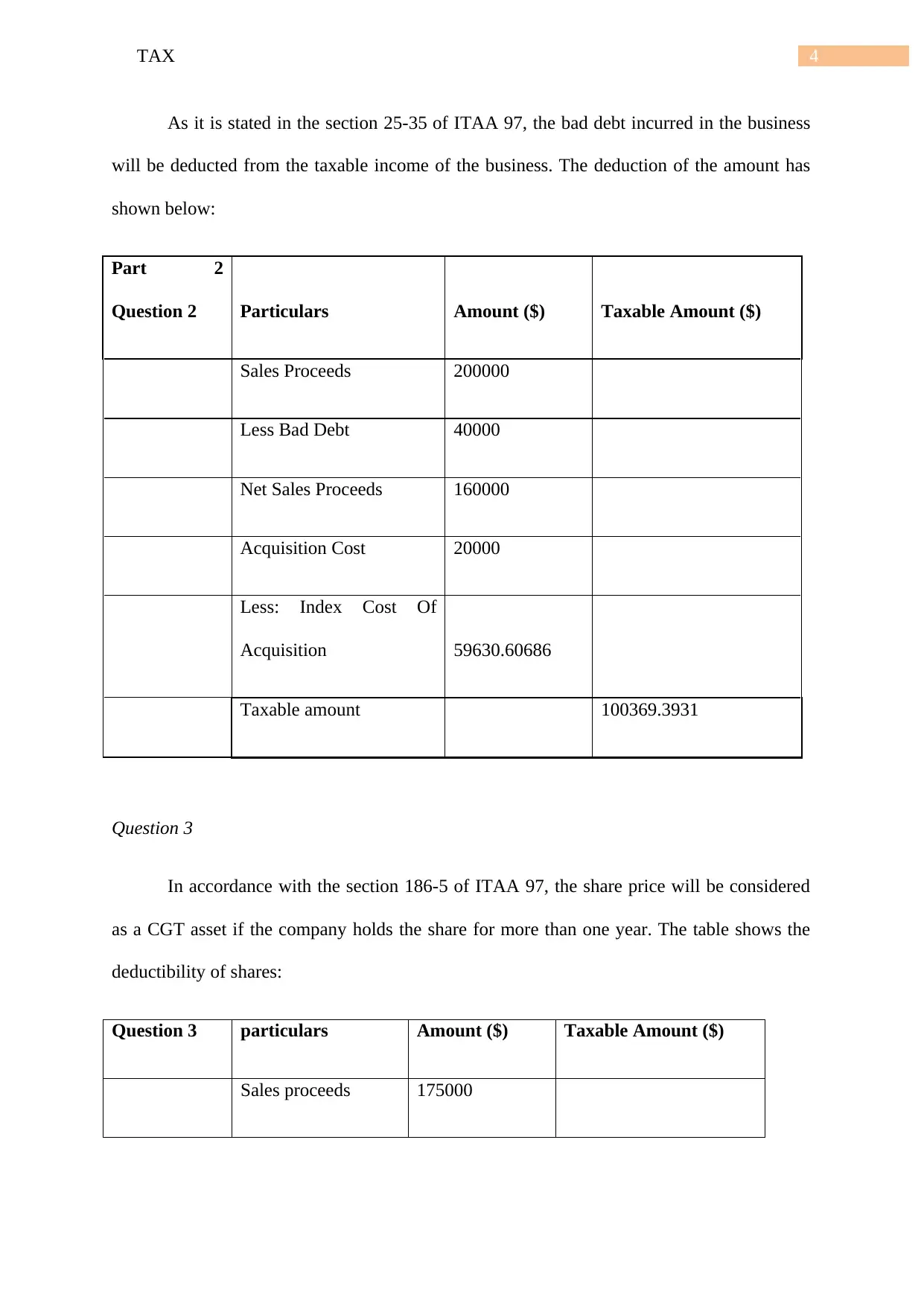
4TAX
As it is stated in the section 25-35 of ITAA 97, the bad debt incurred in the business
will be deducted from the taxable income of the business. The deduction of the amount has
shown below:
Part 2
Question 2 Particulars Amount ($) Taxable Amount ($)
Sales Proceeds 200000
Less Bad Debt 40000
Net Sales Proceeds 160000
Acquisition Cost 20000
Less: Index Cost Of
Acquisition 59630.60686
Taxable amount 100369.3931
Question 3
In accordance with the section 186-5 of ITAA 97, the share price will be considered
as a CGT asset if the company holds the share for more than one year. The table shows the
deductibility of shares:
Question 3 particulars Amount ($) Taxable Amount ($)
Sales proceeds 175000
As it is stated in the section 25-35 of ITAA 97, the bad debt incurred in the business
will be deducted from the taxable income of the business. The deduction of the amount has
shown below:
Part 2
Question 2 Particulars Amount ($) Taxable Amount ($)
Sales Proceeds 200000
Less Bad Debt 40000
Net Sales Proceeds 160000
Acquisition Cost 20000
Less: Index Cost Of
Acquisition 59630.60686
Taxable amount 100369.3931
Question 3
In accordance with the section 186-5 of ITAA 97, the share price will be considered
as a CGT asset if the company holds the share for more than one year. The table shows the
deductibility of shares:
Question 3 particulars Amount ($) Taxable Amount ($)
Sales proceeds 175000
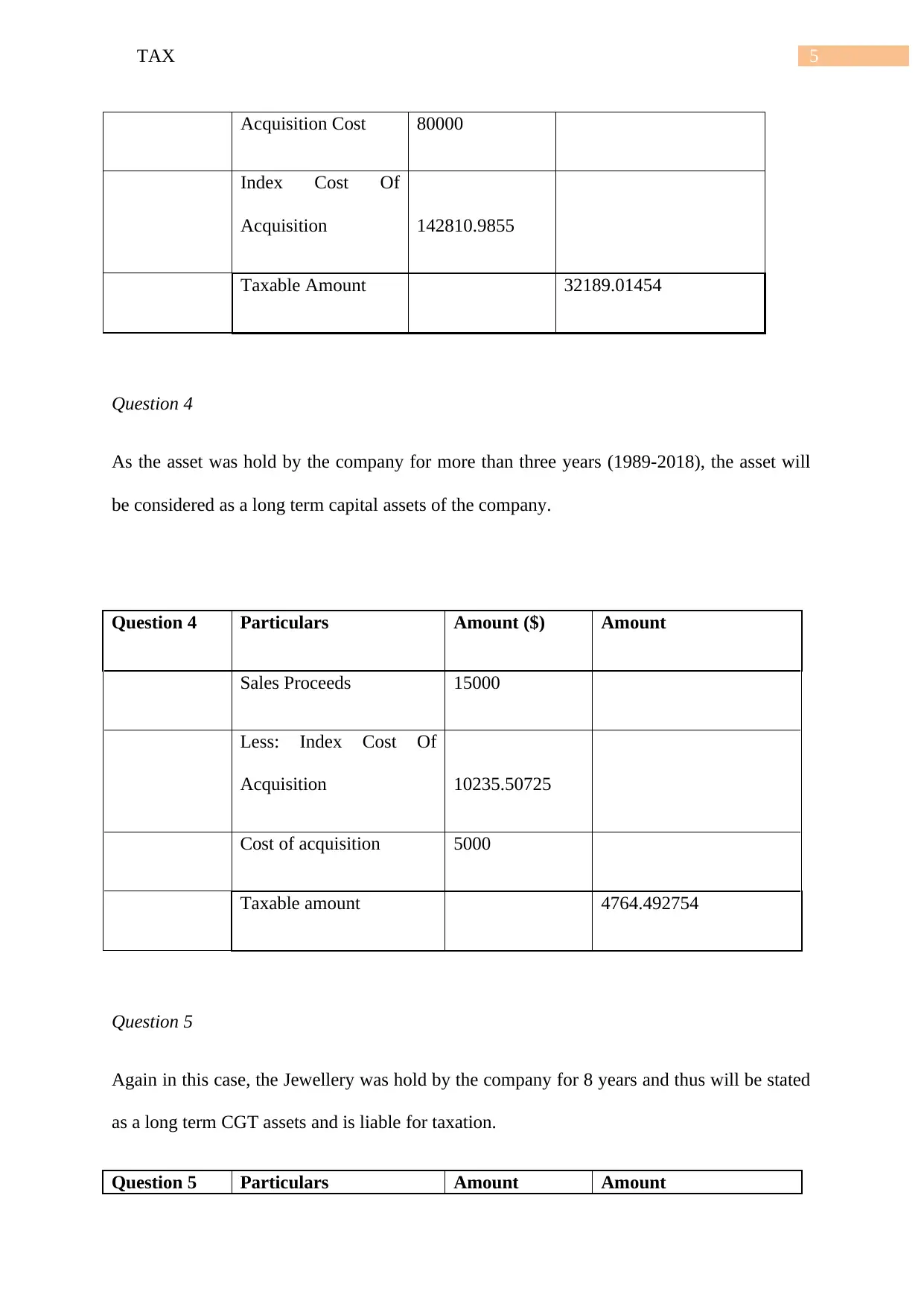
5TAX
Acquisition Cost 80000
Index Cost Of
Acquisition 142810.9855
Taxable Amount 32189.01454
Question 4
As the asset was hold by the company for more than three years (1989-2018), the asset will
be considered as a long term capital assets of the company.
Question 4 Particulars Amount ($) Amount
Sales Proceeds 15000
Less: Index Cost Of
Acquisition 10235.50725
Cost of acquisition 5000
Taxable amount 4764.492754
Question 5
Again in this case, the Jewellery was hold by the company for 8 years and thus will be stated
as a long term CGT assets and is liable for taxation.
Question 5 Particulars Amount Amount
Acquisition Cost 80000
Index Cost Of
Acquisition 142810.9855
Taxable Amount 32189.01454
Question 4
As the asset was hold by the company for more than three years (1989-2018), the asset will
be considered as a long term capital assets of the company.
Question 4 Particulars Amount ($) Amount
Sales Proceeds 15000
Less: Index Cost Of
Acquisition 10235.50725
Cost of acquisition 5000
Taxable amount 4764.492754
Question 5
Again in this case, the Jewellery was hold by the company for 8 years and thus will be stated
as a long term CGT assets and is liable for taxation.
Question 5 Particulars Amount Amount
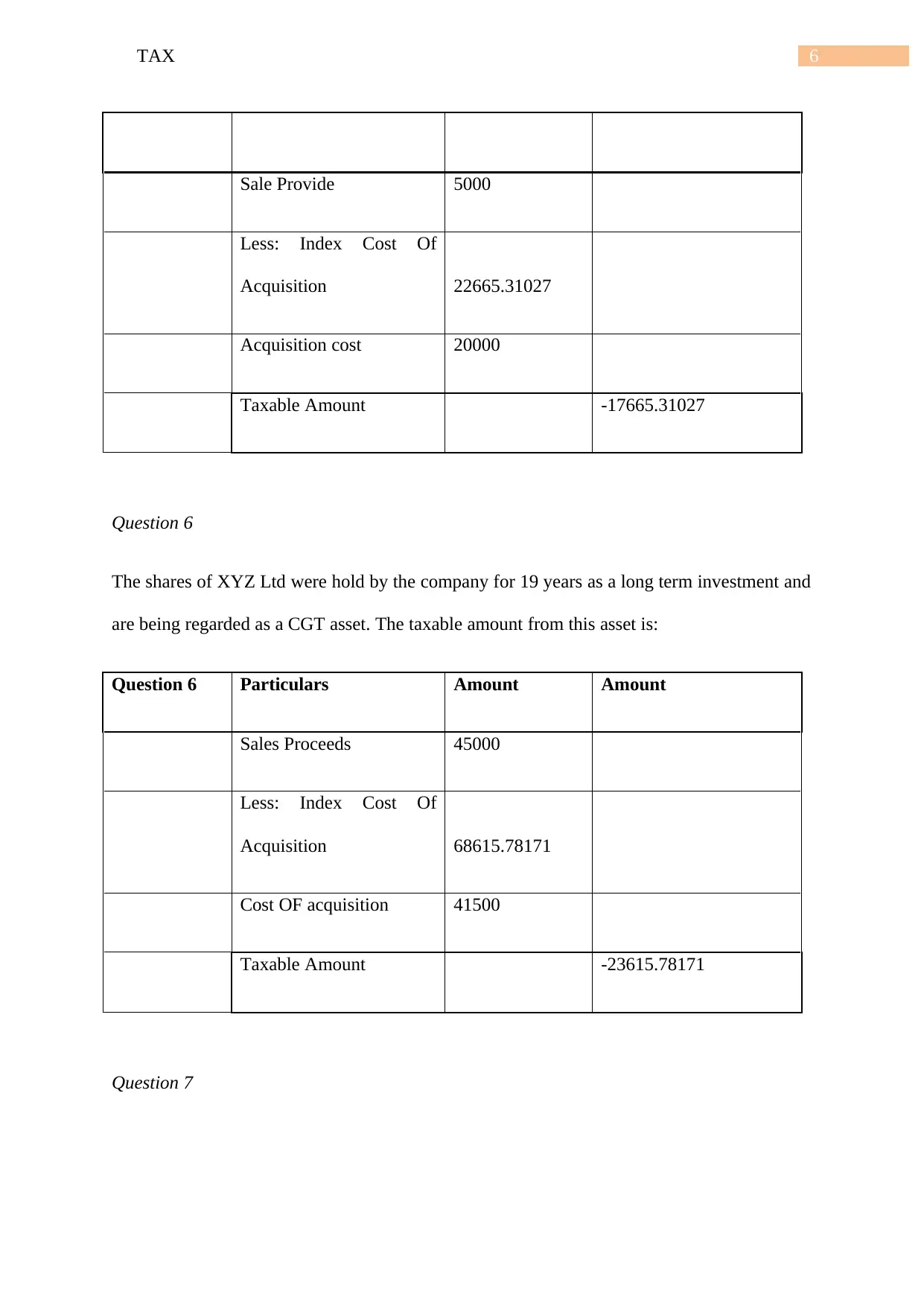
6TAX
Sale Provide 5000
Less: Index Cost Of
Acquisition 22665.31027
Acquisition cost 20000
Taxable Amount -17665.31027
Question 6
The shares of XYZ Ltd were hold by the company for 19 years as a long term investment and
are being regarded as a CGT asset. The taxable amount from this asset is:
Question 6 Particulars Amount Amount
Sales Proceeds 45000
Less: Index Cost Of
Acquisition 68615.78171
Cost OF acquisition 41500
Taxable Amount -23615.78171
Question 7
Sale Provide 5000
Less: Index Cost Of
Acquisition 22665.31027
Acquisition cost 20000
Taxable Amount -17665.31027
Question 6
The shares of XYZ Ltd were hold by the company for 19 years as a long term investment and
are being regarded as a CGT asset. The taxable amount from this asset is:
Question 6 Particulars Amount Amount
Sales Proceeds 45000
Less: Index Cost Of
Acquisition 68615.78171
Cost OF acquisition 41500
Taxable Amount -23615.78171
Question 7
Paraphrase This Document
Need a fresh take? Get an instant paraphrase of this document with our AI Paraphraser
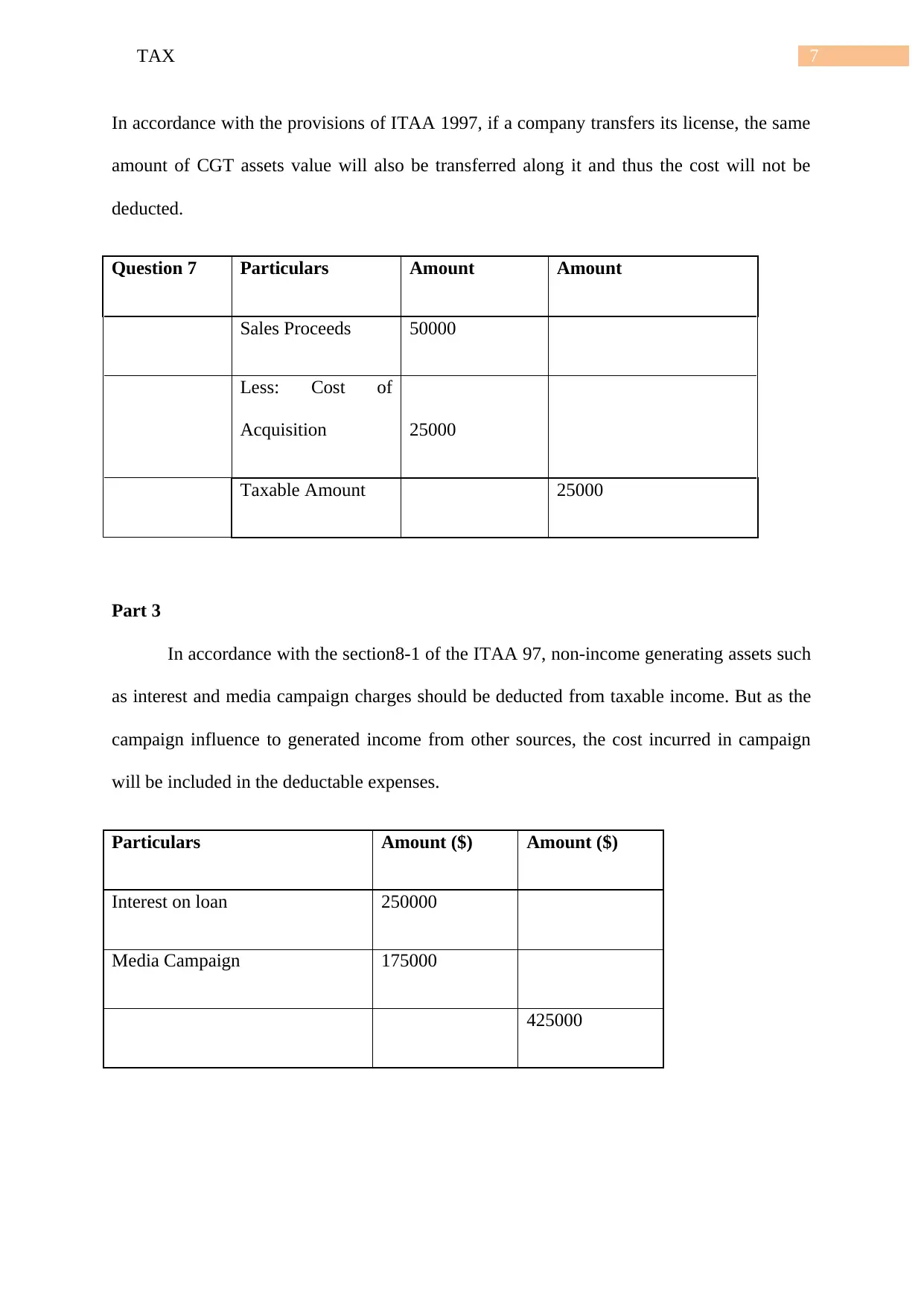
7TAX
In accordance with the provisions of ITAA 1997, if a company transfers its license, the same
amount of CGT assets value will also be transferred along it and thus the cost will not be
deducted.
Question 7 Particulars Amount Amount
Sales Proceeds 50000
Less: Cost of
Acquisition 25000
Taxable Amount 25000
Part 3
In accordance with the section8-1 of the ITAA 97, non-income generating assets such
as interest and media campaign charges should be deducted from taxable income. But as the
campaign influence to generated income from other sources, the cost incurred in campaign
will be included in the deductable expenses.
Particulars Amount ($) Amount ($)
Interest on loan 250000
Media Campaign 175000
425000
In accordance with the provisions of ITAA 1997, if a company transfers its license, the same
amount of CGT assets value will also be transferred along it and thus the cost will not be
deducted.
Question 7 Particulars Amount Amount
Sales Proceeds 50000
Less: Cost of
Acquisition 25000
Taxable Amount 25000
Part 3
In accordance with the section8-1 of the ITAA 97, non-income generating assets such
as interest and media campaign charges should be deducted from taxable income. But as the
campaign influence to generated income from other sources, the cost incurred in campaign
will be included in the deductable expenses.
Particulars Amount ($) Amount ($)
Interest on loan 250000
Media Campaign 175000
425000
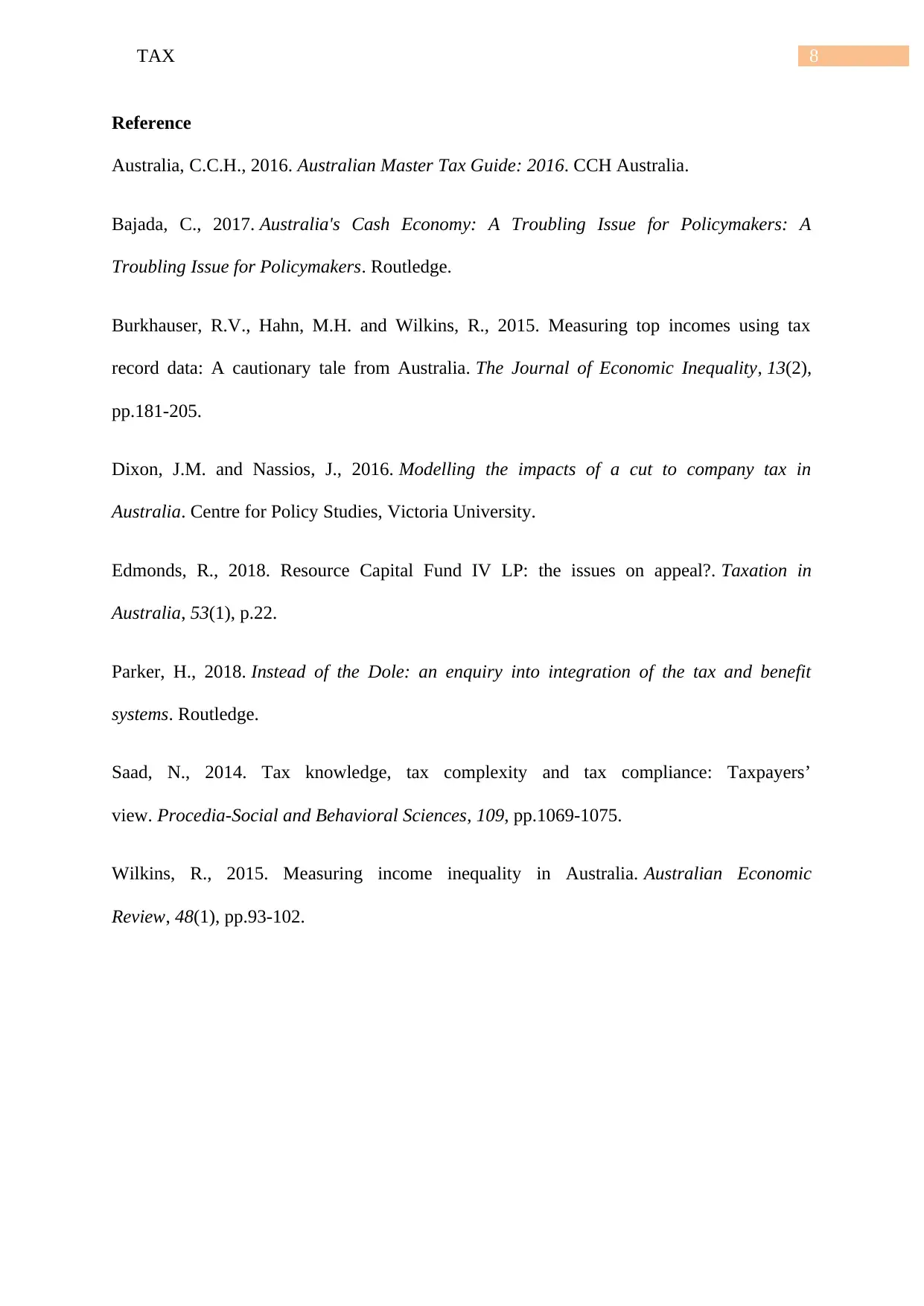
8TAX
Reference
Australia, C.C.H., 2016. Australian Master Tax Guide: 2016. CCH Australia.
Bajada, C., 2017. Australia's Cash Economy: A Troubling Issue for Policymakers: A
Troubling Issue for Policymakers. Routledge.
Burkhauser, R.V., Hahn, M.H. and Wilkins, R., 2015. Measuring top incomes using tax
record data: A cautionary tale from Australia. The Journal of Economic Inequality, 13(2),
pp.181-205.
Dixon, J.M. and Nassios, J., 2016. Modelling the impacts of a cut to company tax in
Australia. Centre for Policy Studies, Victoria University.
Edmonds, R., 2018. Resource Capital Fund IV LP: the issues on appeal?. Taxation in
Australia, 53(1), p.22.
Parker, H., 2018. Instead of the Dole: an enquiry into integration of the tax and benefit
systems. Routledge.
Saad, N., 2014. Tax knowledge, tax complexity and tax compliance: Taxpayers’
view. Procedia-Social and Behavioral Sciences, 109, pp.1069-1075.
Wilkins, R., 2015. Measuring income inequality in Australia. Australian Economic
Review, 48(1), pp.93-102.
Reference
Australia, C.C.H., 2016. Australian Master Tax Guide: 2016. CCH Australia.
Bajada, C., 2017. Australia's Cash Economy: A Troubling Issue for Policymakers: A
Troubling Issue for Policymakers. Routledge.
Burkhauser, R.V., Hahn, M.H. and Wilkins, R., 2015. Measuring top incomes using tax
record data: A cautionary tale from Australia. The Journal of Economic Inequality, 13(2),
pp.181-205.
Dixon, J.M. and Nassios, J., 2016. Modelling the impacts of a cut to company tax in
Australia. Centre for Policy Studies, Victoria University.
Edmonds, R., 2018. Resource Capital Fund IV LP: the issues on appeal?. Taxation in
Australia, 53(1), p.22.
Parker, H., 2018. Instead of the Dole: an enquiry into integration of the tax and benefit
systems. Routledge.
Saad, N., 2014. Tax knowledge, tax complexity and tax compliance: Taxpayers’
view. Procedia-Social and Behavioral Sciences, 109, pp.1069-1075.
Wilkins, R., 2015. Measuring income inequality in Australia. Australian Economic
Review, 48(1), pp.93-102.
1 out of 9
Related Documents
Your All-in-One AI-Powered Toolkit for Academic Success.
+13062052269
info@desklib.com
Available 24*7 on WhatsApp / Email
![[object Object]](/_next/static/media/star-bottom.7253800d.svg)
Unlock your academic potential
© 2024 | Zucol Services PVT LTD | All rights reserved.





